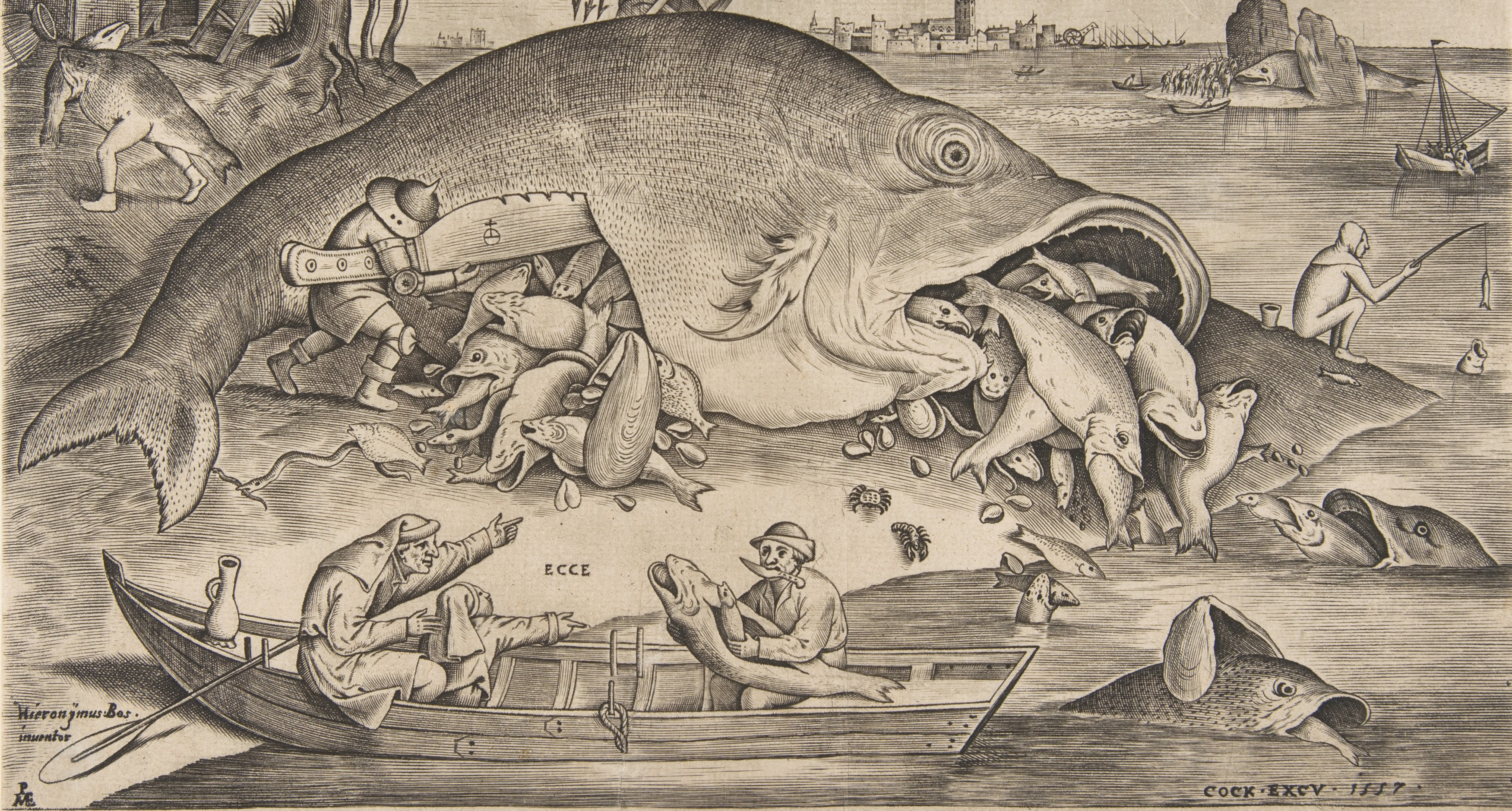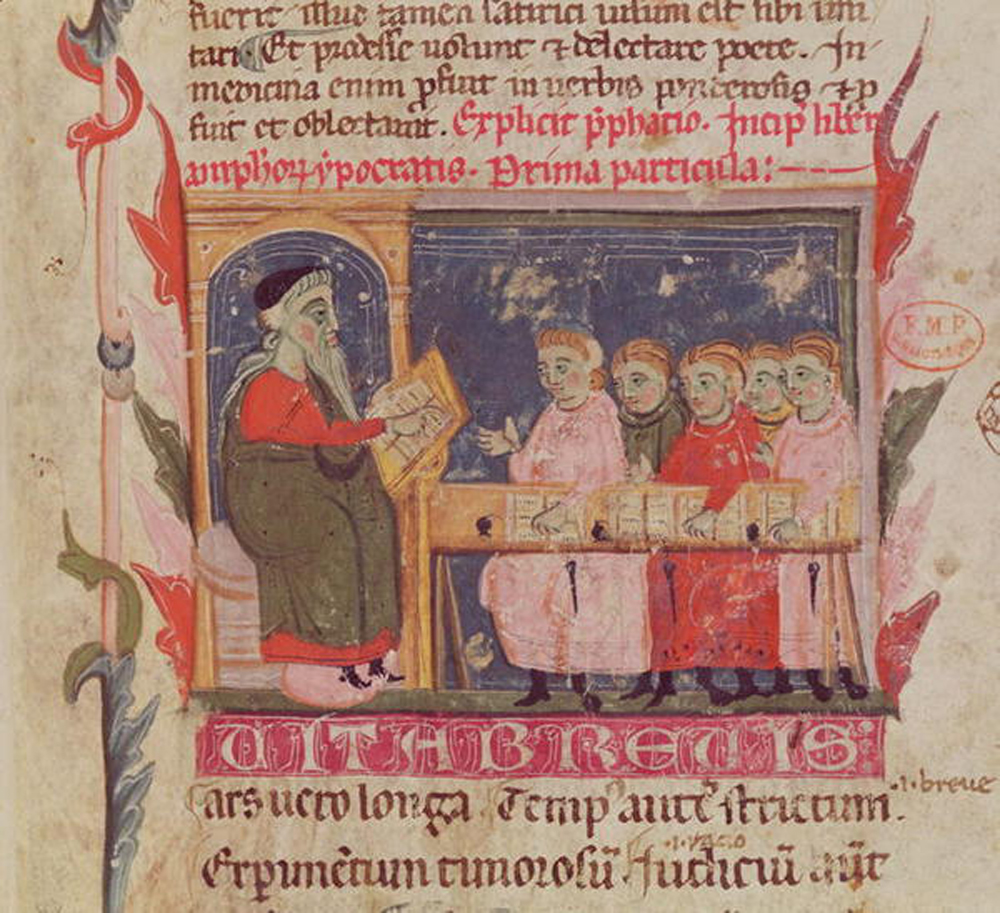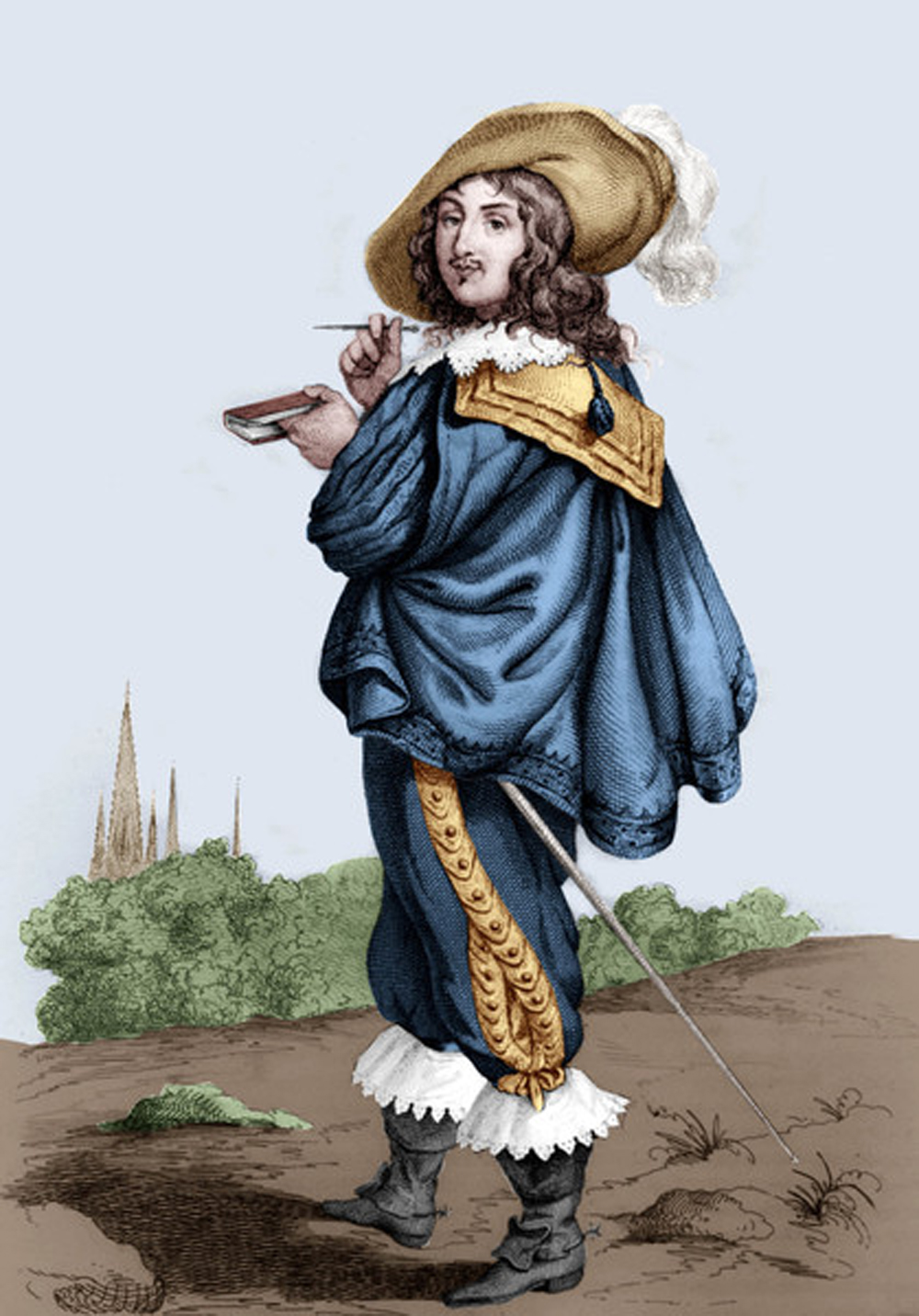
Detail of Big Fish Eat Little Fish, by Pieter Bruegel the Elder, engraving by Pieter van der Heyden, 1557. The Metropolitan Museum of Art, Harris Brisbane Dick Fund, 1917. This is among the first of Bruegel’s many illustrations of proverbs.
For a word that literally means definition, the aphorism is a rather indefinite genre. It bears a family resemblance to the fragment, the proverb, the maxim, the hypomnema, the epigram, the mantra, the parable, and the prose poem. Coined sometime between the fifth and third centuries BC as the title for one of the books of the Corpus Hippocraticum, the Aphorismi were originally a compendium of the latest medical knowledge. The penultimate aphorism, “In chronic disease an excessive flux from the bowels is bad,” is more representative of the collection’s contents than the first—“Life is short, art is long”—for which it is best known.
But in those six words lies a clue to the particular space aphorisms were supposed to define. Thanks to a semantic slippage between the Greek word techne and its English translation (via the Latin ars), the saying is often taken to mean that the works of human beings outlast their days. But in its original context, Hippocrates or his editors probably intended something more pragmatic: the craft of medicine takes a long time to learn, and physicians have a short time in which to learn it. Although what aphorisms have in common with the forms listed above is their brevity, what is delimited by the aphorism is not the number of words in which ideas are expressed but the scope of their inquiry. Unlike Hebrew proverbs, in which the beginning of wisdom is the fear of God, the classical aphorism is a secular genre concerned with the short span of time we are allotted on earth. Books of aphorisms are also therapeutic in nature, collections of practical wisdom through which we can rid ourselves of unnecessary suffering and achieve what Hippocrates’ contemporary Socrates called eudaimonia, the good life.

This is certainly what the Stoic philosopher Arrian had in mind when he whittled down the discourses of his master, Epictetus, into a handbook of aphorisms. The Enchiridion is composed of that mixture of propositional assertion and assertive imperative that is now a hallmark of the form. In it, Epictetus, a former slave, outlines the Stoic view that, while “some things are in our control,” most things are ruled by fate. The way to the good life is to bring what is up to us—our attitudes, judgments, and desires—into harmony with what is not up to us: what happens to our bodies, possessions, and reputations. If we accept that what does happen must happen, we will never be disappointed by vain hopes or sudden misfortunes. Our dispositions, not our destinies, are the real source of our unhappiness. “Never say of anything ‘I have lost it,’” Epictetus advises with characteristic froideur, “but ‘I have returned it.’ Is your child dead? I have returned it. Is your wife dead? She is returned. Is your estate taken away? Well, and is that not likewise returned?”
At the other end of the Roman social spectrum was Emperor Marcus Aurelius, whose own book of aphorisms, the Meditations, redescribed Epictetan fatalism as living according to nature. Centuries of social customs and conventional pieties had gotten encrusted on nature, obscuring it from view. The Meditations’ hostility to “common sense” would become another feature of the genre, which often holds that the apparently counterintuitive is actually the truth finally placed right side up. Thus the pompous purple robes worn by senators to flaunt their social status were, viewed from the perspective of nature, nothing more than “sheep’s wool dyed in the blood of a shellfish.” Romantic love culminated in an activity he described as the “rubbing of a piece of intestine, then a convulsion, and the spurting of some mucus.” Marcus believed that eudaimonia could be achieved if we realigned our priorities with those of nature and practiced “indifference to indifferent things.”
The aphorism was particularly well suited to Stoicism. Both the Enchiridion and the Meditations were how-to books. Because aphorisms are short, they are easily committed to memory; their mantra-like repetition was a means of self-discipline and mental training. When the appropriate situation arose, a Stoic would be prepared and act accordingly, neither bewailing his fate nor being seduced by a false appearance of the value of something transitory and external to the self.
In this, both books were representative of classical thought as a whole. According to historian Pierre Hadot, classical thought distinguished philosophy proper from discourse about philosophy. As he writes in Philosophy as a Way of Life, ancient “philosophy presented itself as a therapeutic, intended to cure mankind’s anguish.” For the Greeks and Romans, the aphoristic “it is thus” was always followed by “so be like this.” Aphorisms recorded what Hadot calls “spiritual exercises,” the intellectual equivalents of the purges and venesections prescribed in Hippocrates’ book of medicine.
Much as Marcus’ empire would be swallowed by Christianity, during the Middle Ages the therapeutic functions of the ancient philosophical schools would be taken over by the pastoral care of the Church. The secular and therapeutic halves of classical thought would largely part ways until Friedrich Nietzsche reunited them in the late nineteenth century, as aphorisms crossbred with Old Testament proverbs, New Testament parables, and mystical poetry on the one hand and folk sayings and courtly witticisms on the other. Perhaps no two books embody this schism better than the Pensées of Pascal and the Maxims of La Rochefoucauld.
A mathematical prodigy and a central figure of the scientific revolution, Blaise Pascal became a devotee of Jansenism following a mystical experience at the age of thirty-one. He would later turn his back on science to write an “apologia for the Christian religion,” which would be published as the Pensées after his death in 1662. Although the book owes much of its fragmentary character to the fact that Pascal did not live to complete it, the Pensées’ aphorisms are why it is considered to be a masterpiece of French prose. The portrait of the author that emerges from its pages is of a man tormented by his attempts to reconcile reason with faith, an inventor of a game-theoretical approach to salvation—his infamous “Wager”—who confessed, “The eternal silence of these infinite spaces fills me with dread.”
In Pascal’s view, the human condition is characterized by “inconstancy, boredom, and anxiety,” which could be relieved only by God’s grace. Rather than confront their “wretchedness,” however, people sought distraction from it in “diversions” that ranged from hunting and games to politics, philosophy, and science. “We run heedlessly into the abyss after putting something in front of us to stop us from seeing it,” he writes. The apparent cynicism of Pascal’s Wager can perhaps be explained by his attempt to meet his imagined audience of nonbelievers on its own terms: “One of the ways in which the damned will be confounded is that they will see themselves condemned by their own reason, by which they claimed to condemn the Christian religion.”

Few people exemplified the way of life Pascal criticized more completely than his contemporary François de la Rochefoucauld. A soldier and a courtier involved in palace intrigues and fashionable salons, the duke turned his attention to literary matters after the failure of the aristocracy’s rebellion against the monarchy known as the Fronde. His 1665 collection Refléxions; ou sentences et maximes morales marked a sea change in the history of the form. If the Pensées had attempted to shift therapeutics to Christian terrain, the Maxims dispense with the notion of self-improvement altogether. The imperative mode of the Stoic Marcus and the Christian Pascal is entirely alien to La Rochefoucauld’s sensibility, as if recommending any form of action were in poor taste.
Such characteristic observations as “self-love is the greatest of flatterers” or “virtue would not go far without vanity to escort her” would not have troubled Marcus Aurelius, but the emperor would not have known what to do with cynical statements like “Our virtues are frequently but our vices disguised,” or “There are relapses in the diseases of the mind as in those of the body; what we call a cure is often no more than an intermission or change of disease.” La Rochefoucauld would have countered Pascal’s dread with a shrug of his well-appointed shoulders, elegantly despairing at the possibility that people could reform their behavior thoroughly enough to achieve the good life. The first readers of the Maxims were shocked by this pose. “Ah, what corruption of mind and heart one must have to imagine all that!” exclaimed La Rochefoucauld’s friend Madame de la Fayette, author of La Princesse de Clèves.
La Rochefoucauld worked on his collection for years, revising it until each aphorism perfectly balanced deliberateness with casualness, self-evidence with counterintuitiveness, and impact with concision. The mark of a great mind, he wrote, was to “say many things with few words” (adding, “little minds use many words to say nothing”). With the Maxims the aphorism begins its move from philosophy to literature, where the beauty of expression is the only consolation for the ugliness of what is expressed.
Nietzsche was an admirer of both La Rochefoucauld and Pascal—full-throated in the former case, qualified in the latter—and as a classical philologist he was intimate with the Greco-Roman tradition. Nietzsche found in the aphorism the perfect vehicle for his wide-ranging set of concerns. With it he could bring together cultural and political commentary, art and music criticism, religious and moral history, occasional observations and materialist metaphysics, thought experiments and pithy remarks—all without subordinating them to a single discourse, as so many clunky treatise writers (Kant and Hegel, for example) had done before him.
Nietzsche’s aphorisms have often been dismissed as the rhetorical flourishes of a philosopher incapable of organizing his thoughts. Actually, Gilles Deleuze has argued, they are “the form of a pluralist thought,” a way of finding a formal complement for the position Nietzsche called “perspectivism.” “In so far as the word ‘knowledge’ has any meaning, the world is knowable,” reads one of the notes in his posthumous collection The Will to Power, “but it is interpretable otherwise, it has no meaning behind it, but countless meanings.” What makes truth appear to be singular is not that there is only one possible relationship between it and the world—something on which the mainstream currents of Western philosophy, science, and religion had all agreed for millennia—but that what we call truth is a particular perspective driven by a “lust to rule,” which forces other perspectives “to accept it as a norm.”
Nietzsche wanted to put this perspective under siege. In 1888, months before he succumbed to madness in Turin, he wrote in Ecce Homo—his joyfully immodest autobiography—“At heart I am a warrior.” He deployed aphorisms to attack unexpectedly and from multiple directions the norms of truth and justice that had ruled Western thought since it had been conquered by Platonism and Judeo-Christianity. The various names he gave to his enemy were “decadence,” “nihilism,” “Eurobuddhism,” “romanticism,” and “the will to nothingness.” He called his scorched-earth campaign against it “the revaluation of all values.”
For all his debt to La Rochefoucauld, Nietzsche did not endorse the Frenchman’s quietism. Instead he reached back to the secular therapeutics of the Stoics. If his metaphors were martial as often as they were medical, it was because the patient he sought to cure was not a single person but an entire culture. It was a culture that preferred weakness to strength, the herd to the individual, the invisible world to the visible world, truth to art, and death to life. All of these values needed to be reversed, a process that would require the work of generations, culminating in his infamous Übermensch, a creature that would stand in the same relationship to mankind as mankind stood to the ape. “Man,” spoke Nietzsche’s fictional surrogate Zarathustra, was “something to be overcome.”
Nietzsche titled one of Ecce Homo’s chapters “Why I Am a Destiny.” Of the many ways in which early twentieth-century intellectual life bore out that claim, perhaps none is more evident than the influence of his writing style: thinkers across Europe resorted to the Nietzschean aphorism to hold a mirror up to the fragmentations of modernity. A list, by no means complete, would have to include George Bernard Shaw’s “Maxims for Revolutionists” in Man and Superman, Karl Kraus’ aphorisms in his journal The Torch, Franz Kafka’s Zürau Aphorisms, Fernando Pessoa’s The Book of Disquiet, E.M. Cioran’s On the Heights of Despair, Walter Benjamin’s One-Way Street, Simone Weil’s Gravity and Grace, and Theodor Adorno’s Minima Moralia.

But it was Ludwig Wittgenstein who would write the book that brought the entire tradition full circle. Comprising nearly 700 numbered sections, few more than a paragraph long, his Philosophical Investigations is considered by many to be the twentieth century’s greatest work of philosophy. Wittgenstein was interested in how the way philosophy was written affected the kinds of conclusions it came to. His choice of the aphorism form was suggested to him by the nature of his investigation, which compelled him “to travel over a wide field of thought criss-cross in every direction.” Because his primary concern was the meaning of meaning, the instrument and object of his investigation (language) were one and the same. He therefore needed a form that would enable him to approach the same point from different angles, “sometimes jumping…from one area to another” to have another look at it.
At first glance, what seems missing from the Investigations is any consideration of ethics. But insofar as ethics is taken as a way of achieving the good life, the Investigations is a deeply ethical book and perhaps the most explicitly therapeutic philosophical text since the Meditations. Defending his unsystematic approach, Wittgenstein wrote: “There is not a philosophical method, though there are indeed methods, like different therapies.” The surprising twist he gave to what, as we have seen, is an old analogy, was in his pathology report. The “disease” Wittgenstein proposed to cure was nothing less than the impulse to philosophize. Problems like skepticism about the external world and other minds, the relationship of mind to body, and the relationship of language to reality are actually painful to people who feel their force. For Wittgenstein, “the real discovery” would be “the one that enables me to stop doing philosophy when I want to. The one that gives philosophy peace, so that it is no longer tormented by questions which bring itself into question.”
Here again the aphorism had a special role to play, for the philosopher’s disease was ocular. When he wasn’t praying for God to grant his fellow philosophers “insight into what lies before everybody’s eyes,” he was admonishing them not to think but to look. Since philosophical problems resulted from a false picture of language, they would disappear only through “a change of aspect,” a fresh way of seeing, rather than a new set of arguments. “A picture held us captive,” Wittgenstein explained. “And we could not get outside it, for it lay in our language and language seemed to repeat it to us inexorably.” We were trapped in language like flies, banging our heads over and over again, because we could not distinguish between glass walls and open space. In his aphorisms, striking metaphors replaced logical proofs; attempts at explanation gave way to thick descriptions of the way language was actually used by people in everyday situations. With the Investigations traditionally literary methods triumphed over philosophical ones. For Wittgenstein, philosophy “ought to be written only as a form of poetry” because only poetry could show “the fly the way out of the fly bottle.”
The first half of the twentieth century may have been the golden age of the aphorism, yet the form, though always somewhat marginal, still flourishes today. Despite think pieces asserting that the aphorism has “made a comeback” thanks to diminishing attention spans and the character limit of a certain social networking service, its continued existence has less to do with developments in Silicon Valley than with developments in the ivory tower.
In the academy, literature and philosophy are, quite naturally, devoted less to making literature or doing philosophy than to producing discourse about them. Academic papers and monographs are professional writing—but the aphorism is existential. Its virtues are precisely those frowned upon by peer reviewers and tenure committees. However much today’s aphorists profit from their academic training or enjoy their work as teachers and scholars, the academy seems to offer institutional cover from which to publish the kind of literary work that blends the theoretical insights of writers who are considered proper subjects of scholarship with discursive modes that have no place there.
A member of the creative writing faculty at CalArts, Maggie Nelson had a breakout success with The Argonauts in 2015. It builds on the style Nelson pioneered in her 2009 cult classic Bluets, a series of short numbered meditations on the intellectual and emotional valences of the titular color. Both books are not so much unclassifiable as over-classifiable; because there is no aphorism section at the bookstore, they are just as likely to be shelved under poetry as they are under philosophy, criticism, essay, or memoir.
Wittgenstein is listed as a “principal supplier” for Bluets. Within the first few pages of The Argonauts, Nelson, who “had spent a lifetime devoted to Wittgenstein’s idea that the inexpressible is contained—inexpressibly!—within the expressible” is reading aloud from the Investigations in an attempt to convince her new lover and future partner Harry Dodge that “words are good enough” despite their manifest failures of expression. The story of Dodge’s transitioning—which, along with Nelson’s pregnancy, provides the narrative braid of The Argonauts—twists but does not sever Nelson’s faith in the sufficiency of language to capture identities, especially our genders and sexualities. What to call Harry first of all? Which pronoun to use? And then, how to linguistically “define” their relation to each other? Nelson writes:
Words change depending on who uses them; there is no cure. The answer isn’t just to introduce new words (boi, cisgendered, andro-fag) and then set out to reify their meanings…One must be alert to the multitude of possible uses, possible contexts, the wings with which each word can fly. Like when you whisper, You’re just a hole, letting me fill you up. Like when I say husband.
Because The Argonauts is “the outline of a becoming” that remains alive to the contingencies of shifting contexts, Nelson exceeds even Wittgenstein’s turn to the literary, incorporating narrative as well as poetry into the aphoristic form. But the book is no less therapeutic for preferring to represent rather than prescribe. It does not tell its readers how to be but offers one picture of what being might be like, and how two unique identities could express themselves to each other with and across the imperfections of a shared language.
Wittgenstein also makes a cameo appearance in Valeria Luiselli’s Sidewalks (2010), but the presiding spirit is the Walter Benjamin of One-Way Street. Born in Mexico City, the peripatetic Luiselli has also lived in South Africa and India. In 2011 she moved to New York, where she has written two novels and completed a dissertation about architecture and literature at Columbia University. Travel between, through, and above urban spaces—there are airplanes, thoroughfares, and bike lanes, but also construction sites, cemeteries, and empty gaps or relingos—is the guiding thread of her book. Luiselli is Benjamin’s flâneur—à velo.
Writing and urbanism do a wary two-step in Sidewalks. Luiselli is ambivalent about Wittgenstein’s claim that “language can be seen as an ancient city.” The “metaphor is tempting,” she writes in “Stuttering Cities,” “but things look very different from where I sit” in Mexico City. “Here, language and the city are the threshold in which I wait for the next earthquake.” In fact, she writes in “Relingos: The Cartography of Empty Spaces,” the metaphor should probably be inverted. Writing isn’t filling up relingos (i.e., the page) by constructing in prose. It is “drilling walls, breaking windows, blowing up buildings.” Whether they are tectonic plates shifting beneath the surface of a paragraph or the double wrecking ball of the line break above and below every aphorism, the formal choices of Sidewalks are in conversation with the loud silences and composed fragmentations inherent in life and literature.
Creative destruction is a central conceit in Matches: A Light Book (2015) by the Polish Canadian philosopher and novelist S.D. Chrostowska, a professor of the humanities and political thought at York University in Toronto. Here the aphorism is a short stick whose tip is struck, burns bright, and turns into memory and ash. As in the writings of Nietzsche and Adorno, the targets of Chrostowska’s illuminating arson are cultural: the art world, publishing, academia, popular media, political economy, and the various phenomena that are the warp and woof of our daily newsfeeds. The purple robes that so exorcised Marcus Aurelius find their equivalents in Chrostowska’s critique of the tech “wearables” that enable “self-micromanagement” to be “glamorized as ‘life-hacking.’” Pascal’s “distractions” are multiplied exponentially in “an attention-deficit economy.” Wittgenstein may have showed his flies out of the fly bottle, Chrostowska wrote, only to get them stuck in “the flypaper” of his own book.
At more than 500 pages, Matches is an epic of the little form. Encyclopedic in its range and ambition, it includes nearly every variant on the aphorism attempted since the Corpus Hippocraticum. The book puts itself in dialogue with its most important practitioners as well as with today’s thinkers. Because of this, it would be reasonable to regard Matches as an exercise in pastiche that intends to exhaust and end the form. But Chrostowska reminds us, “The aphorist is the houdini of reason,” and has been for centuries. Not everything that burns is necessarily consumed; the last aphorism of her book reads: “Endings. Can be eelusive.”